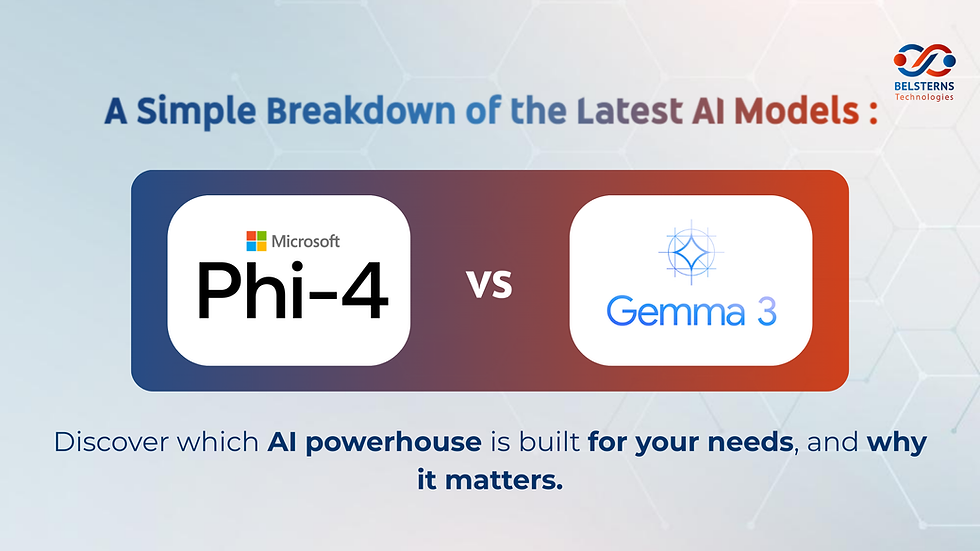Microsoft’s Phi-4 vs Google’s Gemma 3: A Simple Breakdown of the Latest AI Models
- Philip Moses
- Mar 14
- 4 min read
Updated: May 23
Artificial Intelligence (AI) is advancing at an incredible pace, and two of the biggest tech giants, Microsoft and Google, are leading the charge. Recently, Microsoft unveiled its Phi-4 model, while Google introduced Gemma 3. Both are cutting-edge AI systems designed to push the boundaries of what machines can do. But how do they compare? Let’s break it down in simple terms.

What Are Phi-4 and Gemma 3?
Microsoft’s Phi-4 is the latest in Microsoft’s line of AI models. It’s designed to be highly efficient, capable of understanding and generating human-like text, solving complex problems, and even assisting in coding tasks. Phi-4 is part of Microsoft’s broader strategy to integrate AI into its products, like Office 365 and Azure, making everyday tools smarter and more intuitive.
Google’s Gemma 3, on the other hand, is Google’s newest AI model, built to compete with the best in the industry. Gemma 3 focuses on versatility, aiming to excel in tasks like natural language processing, image recognition, and even real-time decision-making. It’s designed to power Google’s services, like Search, Assistant, and Workspace, while also being available for developers to build their own applications.
Key Differences Between Phi-4 and Gemma 3
Purpose and Focus
Phi-4 is tailored for efficiency and integration into Microsoft’s ecosystem. It’s optimized for tasks like document editing, data analysis, and coding assistance.
Gemma 3 is more versatile, aiming to handle a wider range of tasks, from language translation to image generation. It’s built to be a jack-of-all-trades in the AI world.
Performance
Phi-4 shines in specialized tasks. For example, it’s incredibly fast at generating code or summarizing long documents. Microsoft claims it’s 20% more efficient than its predecessor, Phi-3.
Gemma 3, meanwhile, is designed for broader applications. It performs exceptionally well in multi-modal tasks (like combining text and image processing) and is reportedly 15% faster than Gemma 2 in real-world scenarios.
Accessibility
Phi-4 is deeply integrated into Microsoft’s products, meaning it’s primarily available to users of tools like Word, Excel, and Teams. Developers can also access it through Azure AI services.
Gemma 3 is more open. Google has made it available to developers through its Vertex AI platform, allowing anyone to build applications using Gemma 3’s capabilities.
Training Data
Phi-4 is trained on a mix of publicly available data and proprietary datasets from Microsoft. This makes it highly effective for enterprise and professional use cases.
Gemma 3 uses Google’s vast repository of data, including web pages, books, and even real-time user interactions. This gives it an edge in understanding diverse and dynamic information
Strengths and Weaknesses

Phi-4 Strengths:
Extremely efficient for specific tasks like coding and document processing.
Seamless integration with Microsoft’s ecosystem.
Lower computational requirements, making it cost-effective for businesses.
Phi-4 Weaknesses:
Less versatile compared to Gemma 3.
Limited accessibility outside Microsoft’s ecosystem.
Gemma 3 Strengths:
Highly versatile, capable of handling a wide range of tasks.
Open to developers, encouraging innovation.
Strong performance in multi-modal applications.
Gemma 3 Weaknesses:
Requires more computational power, which can increase costs.
May not be as specialized as Phi-4 for certain tasks.
Real-World Applications
Phi-4 in Action: Imagine you’re working on a project in Microsoft Teams. Phi-4 can help you draft emails, summarize meeting notes, and even suggest code snippets if you’re a developer. It’s like having a smart assistant that knows exactly what you need within the Microsoft environment.
Gemma 3 in Action:
Gemma 3, on the other hand, could power a Google Search that not only finds information but also generates summaries, answers complex questions, and even creates visuals to explain concepts. It’s also being used in healthcare to analyze medical images and provide real-time insights.
Which One is Better?
The answer depends on your needs.
If you’re a business deeply embedded in Microsoft’s ecosystem, Phi-4 is a no-brainer. It’s efficient, cost-effective, and tailored for professional use.
If you’re looking for a more versatile AI that can handle a variety of tasks and is accessible for development, Gemma 3 is the better choice.
The Future of AI
Both Phi-4 and Gemma 3 represent the next step in AI evolution. They’re not just tools; they’re platforms that will enable new innovations across industries. As these models continue to improve, we can expect even more seamless integration into our daily lives, from smarter virtual assistants to AI-driven healthcare solutions.
Final Thoughts
Microsoft’s Phi-4 and Google’s Gemma 3 are both impressive in their own right. While Phi-4 excels in efficiency and specialization, Gemma 3 offers versatility and openness. The competition between these two models is a win for everyone, as it drives innovation and pushes the boundaries of what AI can achieve.
Whether you’re a business owner, a developer, or just someone curious about AI, both Phi-4 and Gemma 3 are worth keeping an eye on. They’re not just the future of technology—they’re shaping the future of how we work, learn, and live.


Comments